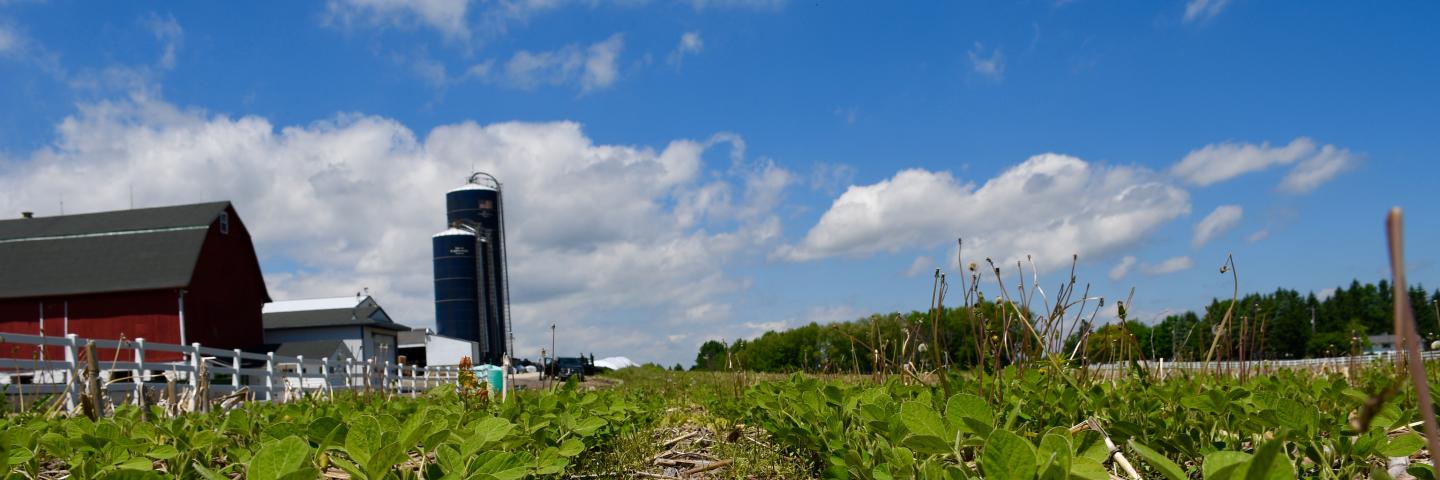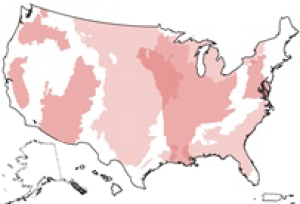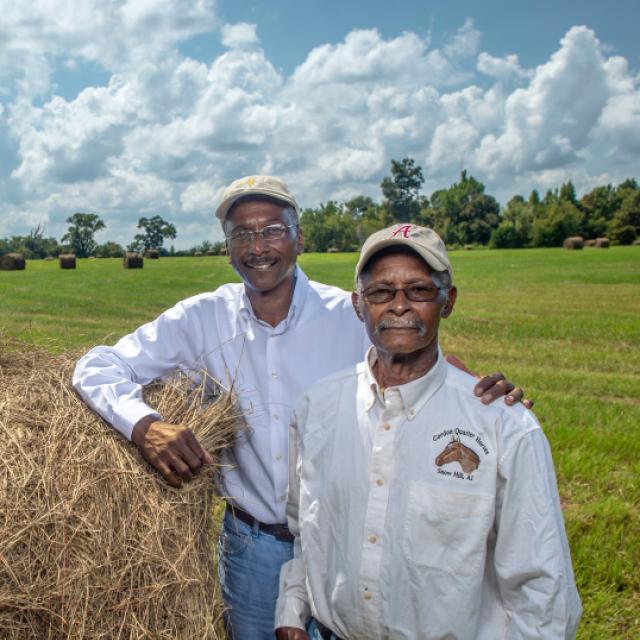
The Regional Conservation Partnership Program (RCPP) is a partner-driven approach to conservation that funds solutions to natural resource challenges on agricultural land.

By leveraging collective resources and collaborating on common goals, RCPP demonstrates the power of public-private partnerships in delivering results for agriculture and conservation.
RCPP projects fall under two different categories: RCPP Classic and RCPP Alternative Funding Arrangements (AFAs). RCPP Classic projects are implemented using NRCS contracts and easements with producers, landowners and communities, in collaboration with project partners. Through RCPP AFAs, NRCS provides funding to partners to support conservation activities with eligible producers and landowners on eligible land. RCPP AFA funding reimburses partners for conservation activities done for or on behalf of producers, landowners, or other entities.
Latest Information
RCPP Improvement Effort
USDA’s NRCS has identified ways to streamline and simplify RCPP, ease the burden on employees and partners, and help maximize flexibility for partners to leverage their investments with NRCS resources and capabilities.
RCPP Partners and Impact
1. Impact—RCPP applications must propose effective and compelling solutions that address one or more natural resource priorities to help solve natural resource challenges. Partners are responsible for evaluating a project’s impact and results.
2. Partner Contributions—Partners are responsible for identifying any combination of cash and in-kind value-added contributions to leverage NRCS’s RCPP investments. It is NRCS’s goal that partner contributions at least equal the NRCS investment in an RCPP project. Substantive partner contributions are given priority consideration as part of the RCPP application evaluation criteria.
3. Partnerships and Management—Partners must have experience, expertise, and capacity to manage the partnership and project, provide outreach to producers, and quantify the environmental outcomes of an RCPP project. RCPP ranking criteria give preference to applicants that meaningfully engage historically underserved farmers and ranchers.
See the 2020 - 2022 awarded projects
RCPP Conservation Activities
RCPP projects may include a range of on-the-ground conservation activities implemented by farmers, ranchers and forest landowners. These activities include:
- Land management/land improvement/restoration practices
- Land rentals
- Entity-held easements
- United States-held easements
- Public works/watersheds
A single RCPP project application can propose to employ any combination of these eligible activity types as part of an RCPP project.
For more information on RCPP easements, visit the RCPP easement page.
RCPP Funding Pools
RCPP funding is divided evenly among two funding pools:

Critical Conservation Areas
For projects in eight geographic areas chosen by the Secretary of Agriculture. These receive 50 percent of funding. Learn more about RCPP Critical Conservation Areas.

State/Multistate
For projects in a single state or across several states. These receive 50 percent of funding.
Who is Eligible
Partner Eligibility
Eligible organizations interested in partnering with NRCS on conservation projects can develop applications for the RCPP competition. The lead partner for an RCPP project is the entity that submits an application, and if selected for an award is ultimately responsible for collaborating with NRCS to successfully complete an RCPP project.
See here for details about what types of organizations are eligible to apply.
Producer and Landowner Eligibility
Once NRCS selects a project and executes an RCPP agreement with a lead partner, agricultural producers may participate in an RCPP project in one of two ways. First, producers may engage with project partners and delegate a willing partner to act as their representative in working with NRCS. Second, producers seeking to carry out conservation activities consistent with a RCPP project in the project’s geographic area can apply directly to NRCS.
Land Eligibility
RCPP projects must be carried out on agricultural or nonindustrial private forest land or associated land on which NRCS determines an eligible activity would help achieve conservation benefits (i.e., improved condition of natural resources resulting from implementation of conservation activities).
Eligible conservation activities may be implemented on public lands when those activities will benefit eligible lands as determined by NRCS and are included in the scope of an approved RCPP project.
More Information

How To Apply
Potential partners are invited to propose RCPP projects where NRCS and partners co-invest in impactful and innovative solutions to on-farm, watershed, and regional natural resource concerns.

Resources for Lead Partners
Resources to help awarded partners negotiate an RCPP Programmatic Partnership Agreement, Supplemental Agreements, and how to work with NRCS to implement conservation activities on the ground.

RCPP in Action
RCPP projects are making an impact across the country.

RCPP Easements
Conservation easements protect working agricultural lands, limit nonagricultural uses, and facilitate the restoration and enhancement of wetlands, grasslands, forestlands, and other natural resources.
Active Projects in Arizona Accepting Applications
Applications are accepted year-round. Apply by January 10th to be considered for the FY25 funding cycle unless otherwise noted below.
NOTE:
The Canal 15 - Project# 2318 and Blackwater Laterals - Project# 2931 are accepting applications through Monday, May 19, 2025, for the FY25 funding cycle.
The Northern AZ Grassland Restoration Phase 2 - Project# 2408 will be accepting applications through Friday, May 30, 2025, for the FY25 funding cycle.
Canal 15 - Project# 2318
Year Awarded: Fiscal Year 2021
USDA Funding: $6,363,636.30
Partner-Contributed Funding: $10,690,000.00
Project Timeline: 2023-2028
RCPP Conservation Activities: Land Management Contracts
Arizona Counties: Pinal County
Lead Partner: Gila River Indian Community
Collaborating Partners: U.S. Bureau of Reclamation
NRCS Service Center: Casa Grande Field Office
Summary: The Gila River Indian Community will fulfill two important goals and objectives. The fulfillment of these will benefit the Community’s efforts to protect soil productivity and conserve scarce water resources by placing into pipeline a main irrigation lateral to assist with the sustainable agricultural development within the reservation. Goal 1: Increase agriculture in a sustainable manner while also protecting and improving soil productivity. Community lands that have been fallow for decades due to insufficient water caused by upstream diversions or are being fallowed due to drought will suffer further degradation of the soil and reduced productivity of the land. By placing into pipeline Canal 15, growers will conserve water, thereby enhancing the limited supply. Goal 2: Conserve available on-reservation soil productivity and water resources by efficiently and sustainably delivering water via an enclosed irrigation system. With continued drought and the high probability of a declaration of water shortage on the Colorado River, it is imperative that the Community protect its ability to deliver an adequate water supply to tribal growers by piping existing earthen canals to conserve water resources.
Blackwater Laterals - Project #2931
Year Awarded: Fiscal Year 2023
USDA Funding: $22,865,854.00
Partner-Contributed Funding: $35,690,000.00
Project Timeline: 2024-2029
RCPP Conservation Activities: Land Management Contracts
Arizona Counties: Pinal County
Lead Partner: Gila River Indian Community
Collaborating Partners: U.S. Bureau of Reclamation
NRCS Service Center: Casa Grande Field Office
Summary: As a result of this RCPP, the Gila River Indian Community (Community) will fulfill two equally important goals and their corresponding objectives. The fulfillment of these goals and objectives will benefit the Community’s efforts to protect soil productivity and conserve scarce water resources in a time of extraordinary drought and aridification in the Southwest by 1) constructing 8.5 miles of pipeline (in lieu of open channel canal) as part of the Westside IE and IF alignment that will be 100% funded by P-MIP and 2) place in buried pipeline or concrete-lining 7.61 miles of existing earthen ditches in the Blackwater area. These efforts will assist with sustainable agricultural development within the reservation.
Northern AZ Grassland Restoration Phase 2 - Project# 2408
Year Awarded: Fiscal Year 2020
USDA Funding: $1,046,979.49
Partner-Contributed Funding: $1,474,620.00
Project Timeline: 2022-2026
RCPP Conservation Activities: Land Management Contracts
Arizona Counties: Portions of Gila and Coconino Counties
Lead Partner: Arizona Game and Fish
Collaborating Partners: Mule Deer Foundation, Arizona Elk Society, United States Fish and Wildlife Service Partners Program, Arizona Antelope Federation, and Arizona Deer Association.
Summary: This RCPP Project will continue to address natural resource concerns, specifically Degraded Plant Condition, Fish and Wildlife - Inadequate Habitat, and Insufficient Water Quantity. This five-year collaborative effort will continue to be led by the Arizona Game and Fish Department (AGFD) and include seven partners: two National Forests who will contribute environmental and/or cultural clearances when opportunities arise, and four wildlife conservation organizations (WCOs). The goals of this project are to restore a minimum of 16,750 acres of degraded grassland and savanna habitat and to establish reliable water sources for wildlife on a total of 100,000 acres.
Linking the CAGCS and NAGI - Project# 2073
Year Awarded: Fiscal Year 2019
USDA Funding: $2,857,143.00
Partner-Contributed Funding: $2,867,400.00
Project Timeline: 2021-2026
RCPP Conservation Activities: Land Management Contracts
Arizona Counties: Portions of Yavapai
Lead Partner: Arizona Game and Fish Department
Collaborating Partners: Mule Deer Foundation, Arizona Antelope Federation, Rocky Mountain Elk Foundations, Arizona Department of Forest and Fire Management, and Arizona Deer Association.
Summary: This project seeks to restore grassland and woodland habitat connectivity between two recently completed RCPP projects, the Central Arizona Grassland Conservation Strategy (CAGCS) and the Northern Arizona Grassland Initiative (NAGI). These RCPPs achieved restoration of tens of thousands of acres of grassland habitat in key areas through collaboration between the Arizona Game and Fish Department (AGFD), the Natural Resources Conservation Service (NRCS), agricultural producers and wildlife organizations. Linkage of the two projects through the removal of undesirable woody species will improve wildlife habitat quality by increasing presence of grass, forb, and palatable shrub cover and allowing for easier movement on the larger landscape for pronghorn and mule deer.
Fort Huachuca Sentinel Landscape Conservation - Project# 2264
Year Awarded: Fiscal Year 2021
USDA Funding: $8,441,558.00
Partner-Contributed Funding: $9,426,000.00
Project Timeline: 2022-2026
RCPP Conservation Activities: Land Management Contracts and Easements
Arizona Counties: Portions of Cochise and Santa Cruz Counties
Lead Partner: Arizona Land and Water Trust
Collaborating Partners: Bureau of Land Management Gila District, Arizona Department of Forestry and Fire Management, United States Fish and Wildlife Service, and Arizona Department of Environmental Quality.
Summary: This RCPP project seeks to work collaboratively with partners to protect and enhance the natural resources of the area. This will be done through the use of easements, education, outreach, and increased enrollment in land management activities. This project will help preserve the areas large working ranches, wildlife habitat, open spaces, and rural livelihoods. The project will draw on extensive watershed and water resource research and conservation actions in the focus area to further water resource management. The partners in this project will increase participation in and productivity of conservation collaboration, maximize efficiency of conservation funding and minimize conservation action redundancy.
Improving AZ Strip for Wildlife and Cattle Phase 2 - Project# 2506
Year Awarded: Fiscal Year 2021
USDA Funding: $355,000.00
Partner-Contributed Funding: $500,000.00
Project Timeline: 2022-2026
RCPP Conservation Activities: Land Management Contracts
Arizona Counties: Portions of Mohave and Coconino Counties
Lead Partner: Arizona Game and Fish
Collaborating Partners: Arizona Antelope Federation, Arizona Deer Association, and Mule Deer Foundation.
Summary: The goal of this project is to further address inadequate habitat, water, food availability, and connectivity for a suite of grassland obligate wildlife species. Funded projects will focus on objectives in three main resource areas. First, plant diversity and productivity, second, water distribution and third, project connectivity access on land. Improvements will give added flexibility to wildlife managers, agricultural producers and rangeland managers in implementing conservation practices.
Little Colorado River Watershed Restoration Project #2773
Year Awarded: Fiscal Year 2022
USDA Funding: $454,545.00
Partner-Contributed Funding: $650,000.00
Project Timeline: 2022-2027
RCPP Conservation Activities: Land Management Contracts
Arizona Counties: Portions of Apache County
Lead Partner: Arizona Department of Forestry and Fire Management
Collaborating Partners: Arizona Department of Forestry and Fire Management
Summary: This project will provide the following environmental benefits: reduce the risk of catastrophic wildfire by implementing fuels reduction treatments within the areas of State and private property north of the Wallow Fire burn scar in southern Apache County. Treatments will protect or enhance wildlife habitat for species including the Apache Trout and Mexican Spotted Owl. The objective of this project is to reduction in the trees per acre, and basal area per acre to appropriate historic or recommended levels, resulting in resilient timber stands and reduced fuel loading.
Lyman North Grassland Restoration #2916
Year Awarded: Fiscal Year
USDA Funding: $1,000,000.00
Partner-Contributed Funding: $1,471,000.00
Project Timeline: Portions of Apache County
RCPP Conservation Activities: Land Management Contracts
Arizona Counties: Portions of Apache County
Lead Partner: Apache Natural Resource Conservation District
Collaborating Partners: Arizona Antelope Foundation, Bureau of Land Management, Arizona Association of Conservation Districts, and Arizona Department of Forestry and Fire Management.
Summary: The projects’ goal is to complete landscape scale rangeland improvements within the Apache Natural Resource Conservation District. Project funding will allow the partnership to extend its landscape scale work into the northern portion of the district, positively impacting rangelands, watersheds, and wildlife habitats. By utilizing brush management practices, the Apache NRCD expects to mitigate these resource concerns and achieve goals including restoring natural plant community balance, mitigating wildfire hazards, improving forage quality and quantity, enhancing wildlife habitat, and restoring desired vegetative cover.
Arizona Strip Wildlife and Livestock Habitat Improvement #3292
Year Awarded: Fiscal Year 2024
USDA Funding: $1,219,512.00
Partner-Contributed Funding: $1,919,269.44
Project Timeline: 2024-2029
RCPP Conservation Activities: Land Management Contracts
Arizona Counties: Portions of Mohave and Coconino Counties
Lead Partner: Mule Deer Foundation
Collaborating Partners: Arizona Deer Association, Arizona Game and Fish Department Habitat Branch, and Arizona Game and Fish Department Development Branch.
Summary: The goal of this project is to address inadequate habitat, water, food availability, and connectivity for a suite of wildlife species. Funded projects will focus on objectives in two main resource areas. First, plant diversity and productivity will be addressed on approximately 3,000 acres of areas encroached by juniper and pinyon. Second, water distribution across approximately 253,000 acres will be increased. Improvements will give added flexibility to wildlife managers, agricultural producers, and rangeland managers in implementing conservation practices.
Ready to get started?
Contact your local service center to start your application.
How to Get Assistance
Do you farm or ranch and want to make improvements to the land that you own or lease?
Natural Resources Conservation Service offers technical and financial assistance to help farmers, ranchers and forest landowners.

To get started with NRCS, we recommend you stop by your local NRCS field office. We’ll discuss your vision for your land.
NRCS provides landowners with free technical assistance, or advice, for their land. Common technical assistance includes: resource assessment, practice design and resource monitoring. Your conservation planner will help you determine if financial assistance is right for you.
We’ll walk you through the application process. To get started on applying for financial assistance, we’ll work with you:
- To fill out an AD 1026, which ensures a conservation plan is in place before lands with highly erodible soils are farmed. It also ensures that identified wetland areas are protected.
- To meet other eligibility certifications.
Once complete, we’ll work with you on the application, or CPA 1200.
Applications for most programs are accepted on a continuous basis, but they’re considered for funding in different ranking periods. Be sure to ask your local NRCS district conservationist about the deadline for the ranking period to ensure you turn in your application in time.
As part of the application process, we’ll check to see if you are eligible. To do this, you’ll need to bring:
- An official tax ID (Social Security number or an employer ID)
- A property deed or lease agreement to show you have control of the property; and
- A farm number.
If you don’t have a farm number, you can get one from USDA’s Farm Service Agency. Typically, the local FSA office is located in the same building as the local NRCS office. You only need a farm number if you’re interested in financial assistance.
NRCS will take a look at the applications and rank them according to local resource concerns, the amount of conservation benefits the work will provide and the needs of applicants. View Application Ranking Dates by State.
If you’re selected, you can choose whether to sign the contract for the work to be done.
Once you sign the contract, you’ll be provided standards and specifications for completing the practice or practices, and then you will have a specified amount of time to implement. Once the work is implemented and inspected, you’ll be paid the rate of compensation for the work if it meets NRCS standards and specifications.

